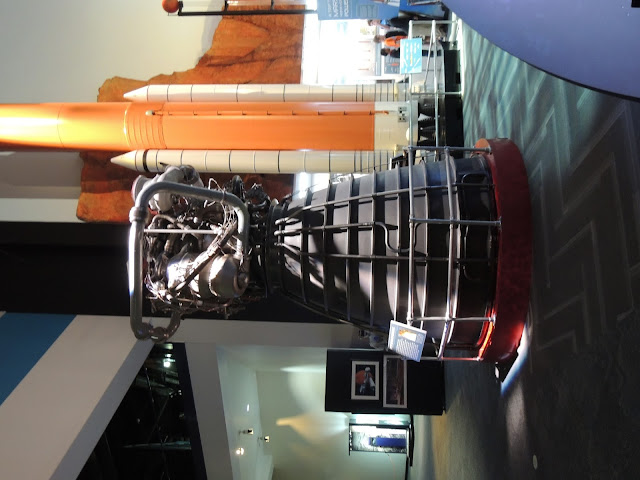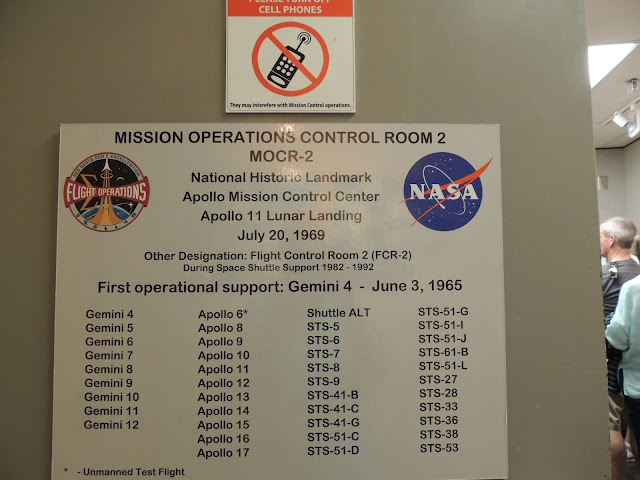The Houston Space Center and
The San Jacinto Monument
Houston, TX
I thought the bark on this tree was interesting, I wonder what kind of tree it is. It was growing at our RV site.
Houston Space Center
At the entrance
We entered the museum and realized it was spring break for a lot of kids. A good deal of the museum is dedicated to interactive displays that kids would love. We couldn't get close to many of the displays. There were various space craft hanging from the ceiling and that was interesting.
We have now been to so many museums and found this one a bit lacking in organization. Maybe that was because we lived the years of space exploration and just expected more, I'm not sure. We found it hard to follow the chronology of the space program.
There are a number of facts that may have clouded our judgement here. Here's the layout, we found it confusing. (maybe we're just old). It was also extremely crowded the day we were there.(it's hard to walk in a straight line with so many people, and kids running to see the next thing). And finally, spring break is not the time to visit.

The National Space Trophy was won by Dr. Charles Elanchi in 2016.
www.rnasa.org/trophy_winners.html
The Mars Mission brought back rocks.
Next Time.
The international space station.
Docking mechanism??? Can't remember.
SkyLab
Time to go outside, it's crowded in here. "Independence Plaza"
It is exciting to actually walk inside the 747 and the shuttle and truly realize just what an amazing and challenging feat these men and women accomplished.
The 747 that shuttled the shuttle.
The cargo bay of the shuttle
A reproduction of the shuttle mounted on the 747.
The Challenger Crew lost in 1986
The Columbia Crew lost in 2003
History in the making.
Necessity is really the mother of invention.
Who is the face in the shuttle window? I think I know her.
The underside of the Shuttle
Close-up of the tiles on the underside of the Shuttle.
What's next?
The walkway to the shuttle.
Across the fence is the Johnson Space Center. Where the real action is.
Back inside the museum.
The Lunar Soil Lab.
Eugene Cernan, the last man on the moon.
The original Gemini and Apollo Mission control center, at the Johnson Space Center, as it looked from 1965 to 1969. It was revamped and used for the shuttle missions from 1982 to 1992. Later it was restored and was designated a National Historic Landmark. Our tour took us into the room where the media watched and reported.
This was the coolest part of the space center and museum.
San Jacinto Monument
http://www.sanjacinto-museum.org/
We were told by a true Texan, that we had to go here.
The San Jacinto Monument is a 567.31-foot-high (172.92-meter) column located on the Houston Ship Channel in unincorporated Harris County, Texas, United States, near the city of Houston. The monument is topped with a 220-ton star that commemorates the site of the Battle of San Jacinto, the decisive battle of the Texas Revolution. The monument, constructed between 1936 and 1939 and dedicated on April 21, 1939, is the world's tallest masonry column and is part of the San Jacinto Battleground State Historic Site. By comparison, the Washington Monument is 554.612 feet (169.046 m) tall, but remains the tallest stone monument in the world. The column is an octagonal shaft topped with a 34-foot (10 m) Lone Star – the symbol of Texas. Visitors can take an elevator to the monument's observation deck for a view of Houston and the Battleship Texas (see USS Texas).
The San Jacinto Museum of History is located inside the base of the monument, and focuses on the history of the Battle of San Jacinto and Texas culture and heritage.
The San Jacinto Battlefield, of which the monument is a part, was designated a National Historic Landmark on December 19, 1960, and is therefore also automatically listed on the National Register of Historic Places. It was designated a Historic Civil Engineering Landmark in 1992. (Taken from Wikipedia)
Engraved story of the Texas Revolution
Here's what wikipedia has to say.
Inscription
An inscription on the monument tells the story of the birth of Texas:
The view from the top floor of the monument.
Memorials around the battleground.







































































































































No comments:
Post a Comment